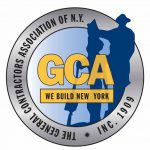Court Grants Defendants’ Motion for Summary Judgment Dismissing Complaint
published on May 08, 2011
Court Grants Defendants’ Motion for Summary Judgment Dismissing Complaint
published on May 08, 2011
In a decision dated May 4, 2011, Justice Sidney F. Strauss granted the motion for summary judgment brought by the defendants, an owner and construction manager, seeking a dismissal of the plaintiff’s complaint containing causes of action for common law negligence and violations of Labor Law §§200 and 241(6). The plaintiff, a concrete laborer, was using a come-a-long and was raking concrete. The floor where he was working was constructed of beams with Q-deck on top and then two layers of rebar on top of the Q-deck. To pour the concrete, several sections of eight-foot hose were connected to each other with clamps. The cement was supplied by a cement truck and pumped up through the hoses. After a section of the floor was poured, the laborers would remove the clamps that held the sections of hose together and the hoses would then be carried to the other side of the floor for washing. Just prior to the accident, the hose had been broken apart by one of the plaintiff’s coworkers. The plaintiff picked up an eight-foot section of hose and hung it over his right shoulder. Part of the those then went through the first level of rebar and became caught in the second level of rebar. While holding the hose with both arms wrapped around it, the plaintiff tried to yank the hose at least five times to free it. The plaintiff then felt something pop in his back and he fell to the floor. The Court dismissed the common law negligence and Labor Law §200 causes of action because the plaintiff’s claims implicated the means and methods of his work and the owner and construction manager did not supervise, direct or control the plaintiff’s work or have notice of any allegedly hazardous condition. Regarding the cause of action for Labor Law §241(6) premised upon violations of Industrial Code Rules 23-1.5, 23-1.7(b)(i) and 23-2.2, the Court determined that the defendants established that the Rules were either general safety provisions or not applicable to the facts of the case.
Squerciati v. The New York Times Building LLC et al., Index No.: 22535/08 (New York Co. Sup. Ct., May 4, 2011)
Court Dismisses All Claims Against Second Third-Party Defendant Safety Auditing Company
published on May 08, 2011
Court Dismisses All Claims Against Second Third-Party Defendant Safety Auditing Company
published on May 08, 2011
n a decision dated April 8, 2011, Justice Charles A. Markey granted second third-party defendant’s motion for summary judgment dismissing all claims and cross-claims against it. The plaintiff was standing on a scaffold dismantling a roll-up garage door. While attempting to remove a fastener for the roll-up mechanism, the mechanism sprung forward, striking the plaintiff in the head. The plaintiff was rendered unconscious and he subsequently fell from the scaffold.
The second third-party defendant was engaged by the City of New York to provide safety auditing services pursuant to a written contract. The indemnification clause in the contract required that the party to be indemnified prove that the second third-party defendant’s negligence caused the plaintiff’s accident. In granting second third-party defendant summary judgment, the Court held that the second third-party defendant was free of any negligence and it did not have actual or constructive notice of any dangerous condition. Therefore, the Court held that no party was entitled to indemnification from the second third-party defendant.
Fernandez v. The City of New York, et al., Index No.: 21228/06 (Queens Co. Sup. Ct., April 8, 2011)
In Memoriam: Irvin Lederer (1952-2011) The partners and associates of Fabiani, Cohen & Hall are saddened by the untimely death of their longtime colleague. Irv was an accomplished litigator and a wonderful person who was beloved by all who knew him. We will truly miss him.
published on April 27, 2011
John V. Fabiani, Jr. and Stephen M. Cohen lectured at a Zurich North America seminar entitled “New York Labor Law §§200, 240(1) & 241(6): A Primer,” in Parsippany, New Jersey.
published on April 15, 2011
John V. Fabiani, Jr. and Stephen M. Cohen lectured at a Zurich North America seminar entitled “New York Labor Law §§200, 240(1) & 241(6): A Primer,” in Parsippany, New Jersey.
published on April 15, 2011
Court Grants General Contractor Summary Judgment On Its Cause Of Action For Contractual Indemnification Against Plaintiff’s Employer
published on February 18, 2011
Court Grants General Contractor Summary Judgment On Its Cause Of Action For Contractual Indemnification Against Plaintiff’s Employer
published on February 18, 2011
In a decision dated February 18, 2011, Justice Judith J. Gische granted the defendant/third-party plaintiff’s (“general contractor”) summary judgment motion seeking contractual indemnification against third-party defendant (“plaintiff’s employer”). The Court found that plaintiff’s employer’s subcontract agreement with the general contractor, which required the plaintiff’s employer to hold harmless and indemnify the general contractor, and the plaintiff’s employer’s insurance rider, which required it to obtain insurance for the benefit of the general contractor, were not inconsistent. Further, as the agreement did not condition plaintiff’s employer’s obligation to indemnify the general contractor on a finding that plaintiff’s employer was negligent, plaintiff’s employer’s obligation to indemnify the general contractor with respect to the plaintiff’s causes of action pursuant to Labor Law §§240(1) and 241(6) was unconditional, and the general contractor’s summary judgment motion was not premature.
Palamar v. Koch Skanska, Inc. et al., Index No.: 114187/04 (New York Co. Sup. Ct., February 18, 2011)
Court Grants Defendant Joint Venture’s Motion for Summary Judgment Dismissing Plainiff’s Complaint Where Defendant Was an “Employer” Within the Meaning of Workers’ Compensation Law §11
published on February 10, 2011
Court Grants Defendant Joint Venture’s Motion for Summary Judgment Dismissing Plainiff’s Complaint Where Defendant Was an “Employer” Within the Meaning of Workers’ Compensation Law §11
published on February 10, 2011
In a decision dated February 11, 2011, Justice Herbert Kramer granted defendant Joint Venture’s motion for summary judgment dismissing plaintiff’s causes of action for common law negligence and pursuant to Labor Law §§200, 240(1) & 241(6). The plaintiff alleged that while in the course of his employment with a member of the Joint Venture, he suffered an injury to his right thumb, which required partial amputation. The Joint Venture moved for summary judgment arguing that an employee of a member of a joint venture is a “special employee” of the joint venture and each of its members. As such, the suit should be barred by Workers’ Compensation Law §11. In support of the motion, the Joint Venture provided evidence that at the time of his accident, the plaintiff was working at the behest of the Joint Venture’s contract with the NYCDEP, that the Joint Venture purchased worker’s compensation coverage from which the plaintiff was drawing benefits and that the Court was bound by the Workers’ Compensation Board’s finding that the Joint Venture was the plaintiff’s employer. In opposition, the plaintiff argued that the language of the agreement between the Joint Venture and the NYCDEP provided that the plaintiff was not an employee of the Joint Venture and that the motion was premature in that additional discovery, including depositions, were required to settle the issue of direction and control over the means and methods of the plaintiff’s work. The Court held that sufficient evidence to grant the motion was found among the undisputed facts and that no further discovery was required. The Court determined that the Joint Venture was a “special employer” within the meaning of Workers’ Compensation Law §11 and issued an order dismissing the action against the Joint Venture with prejudice.
Valencia v. SPMP Joint Venture et al., Index No.: 15355/09 (Kings Co. Sup. Ct., February 11, 2011)
Court Dismisses Complaint and All Cross-Claims As Against Defendant General Contractor
published on January 27, 2011
Court Dismisses Complaint and All Cross-Claims As Against Defendant General Contractor
published on January 27, 2011
In a decision dated January 27, 2011 Justice Martin Solomon dismissed the plaintiff union tile-fitter’s complaint against the defendant “core and shell” general contractor because the general contractor did not owe the plaintiff, who tripped and fell into an open grease trap, a duty of care. The Court held that because the condition was created by the subcontractor of a second, “interior-fit-out,” general contractor, and there was no evidence of shared duties between the “core and shell” contractor and the “interior-fit-out contractor,” the Labor Law did not apply to the “core and shell” contractor.
Seifert v. The City of New York Industrial Development Agency et al., Index No. 14714/05 (Kings Co. Sup. Ct., January 27, 2011)
Court Dismisses Complaint and Co-Defendant’s Cross-Claim for Contractual Indemnification Against Defendant Snow Removal Contractor
published on January 19, 2011
Court Dismisses Complaint and Co-Defendant’s Cross-Claim for Contractual Indemnification Against Defendant Snow Removal Contractor
published on January 19, 2011
In a decision dated January 19, 2011, Justice Angela G. Iannacci dismissed the plaintiff pedestrian’s complaint against the defendant snow removal contractor because it did not owe the plaintiff, who slipped and fell on ice, a duty of care and did not create or exacerbate the alleged ice condition on the sidewalk in front of co-defendant property owner’s premises. In addition, because there was no evidence that the snow removal contractor was negligent in its snow removal, the Court dismissed the property owner’s cross-claim for contractual indemnification as against the snow removal contractor.
Gayer v. Willow Wood Associates, LP et al., Index No. 14285/08 (Nassau Co. Sup. Ct., January 19, 2011)
Court Grants City of New York’s Motion for Summary Judgment Dismissing Plaintiff’s Claims for Common Law Negligence and Pursuant to Labor Law §241(6)
published on January 10, 2011
Court Grants City of New York’s Motion for Summary Judgment Dismissing Plaintiff’s Claims for Common Law Negligence and Pursuant to Labor Law §241(6)
published on January 10, 2011
In a decision dated January 10, 2011, Justice Paul G. Feinman granted defendant the City of New York’s motion for summary judgment dismissing the plaintiffs’ claims for common law negligence and pursuant to Labor Law §200 and §241(6), predicated upon an alleged violation of Industrial Code Rule 23-1.7(e) (tripping hazards). At the time of the accident, the plaintiff, an ironworker, had been replacing steel on the Williamsburg Bridge. His work involved removing rivets with a “helldog.” The rivets were being caught by a cone and then dumped into buckets for removal. At lunchtime, the plaintiff was walking from his work area to a shanty when he allegedly tripped over a broken rivet located approximately 30 feet from his work area. The plaintiff did not see the subject rivet prior to the accident. Judge Feinman held that, despite inspections performed by City employees, there was no evidence that the City supervised or controlled the plaintiff’s work and, as such, the City was entitled to dismissal of the plaintiffs’ cause of action for common law negligence and pursuant to Labor Law §200. The Court further held that, despite the City’s awareness that some rivets may not be caught by the cones, there was no evidence that the City had notice of the alleged condition. Finally, holding that the rivet over which the plaintiff allegedly tripped was integral to the steel replacing work being performed on the Bridge, the Court also dismissed the plaintiffs’ Labor Law §241(6) claim predicated upon an alleged violation of Industrial Code Rule 23-1.7(e) (tripping hazards).
Zieris v. The City of New York, Index No. 103335/06 (N.Y. Co. Sup. Ct., January 10, 2011)
Court of Claims Denies Claimant’s Motion for Partial Summary Judgment Pursuant to Labor Law §§240(1) and 241(6) Because There Was a Question of Fact Regarding Whether Claimant’s Actions Were the Sole Proximate Cause of His Accident
published on December 30, 2010
Court of Claims Denies Claimant’s Motion for Partial Summary Judgment Pursuant to Labor Law §§240(1) and 241(6) Because There Was a Question of Fact Regarding Whether Claimant’s Actions Were the Sole Proximate Cause of His Accident
published on December 30, 2010
The defendants successfully defended the claimant ironworker’s motion for summary judgment pursuant to Labor Law §240(1) and §241(6) predicated upon an alleged violation of Industrial Code Rule 23-1.16(b) (safety belts, harnesses, tail lines and lifelines: attachment required). Although the Court of Claims found that the claimant, who allegedly fell 10 feet to the ground while walking along a steel girder, established a prima facie case that he was not provided with the proper protection, the Court held that there was a question of fact as to whether the claimant was the sole proximate cause of his accident. The defendants proffered evidence that the claimant was required to undergo fall protection training, was supplied with harnesses, lanyards and other safety equipment and knew that he was required to use this equipment. The claimant also should have remained tied off, climbed to the ground and untied, walked along the ground to the other side of the girder, tied off and climbed to the area where he was to continue his work. His failure to remain tied off at all times while at a height raised an issue of fact regarding whether his actions were the sole proximate cause of the accident.
Mell v. The State of New York et al., Index No. 114870 (Court of Claims, December 30, 2010)








